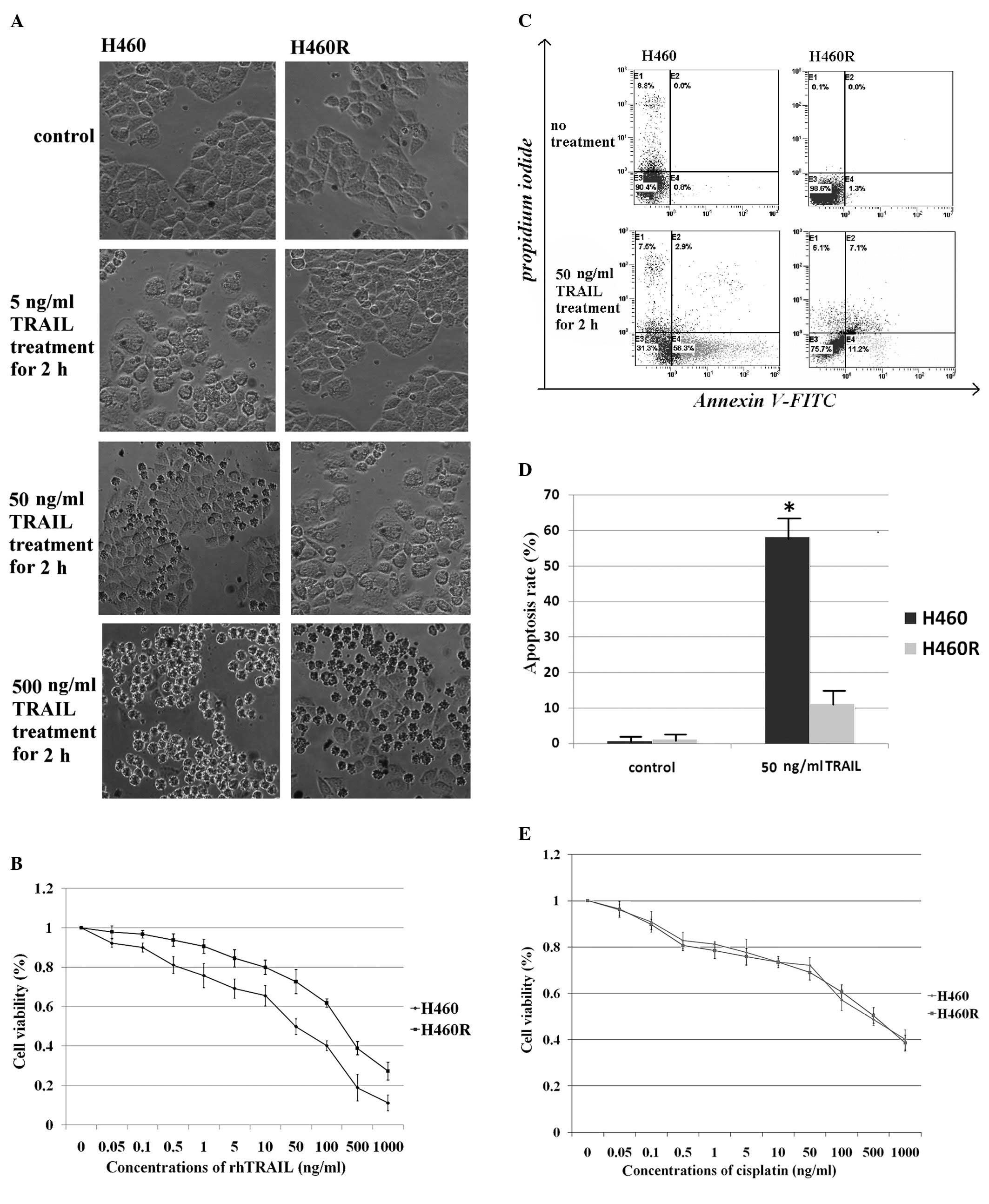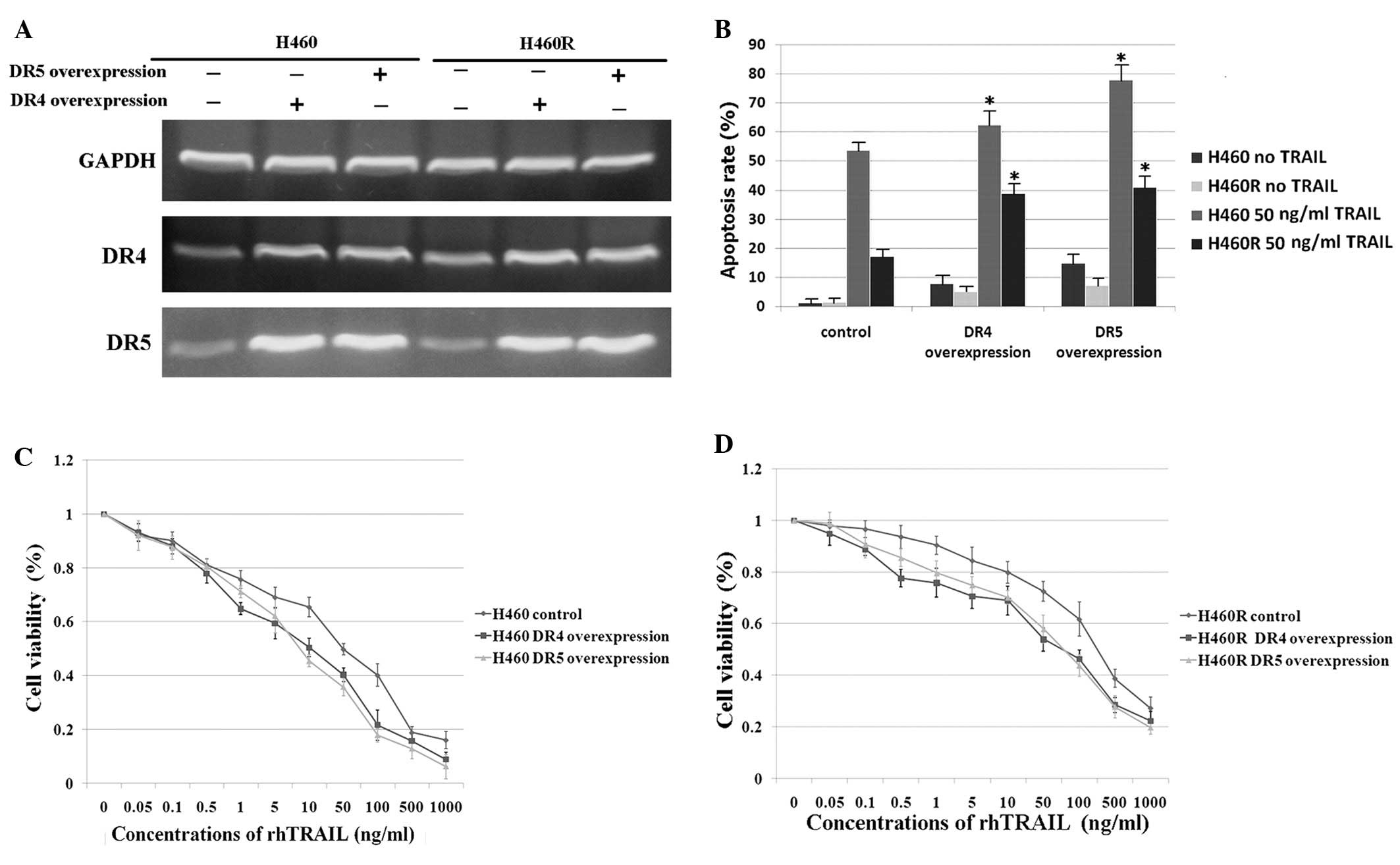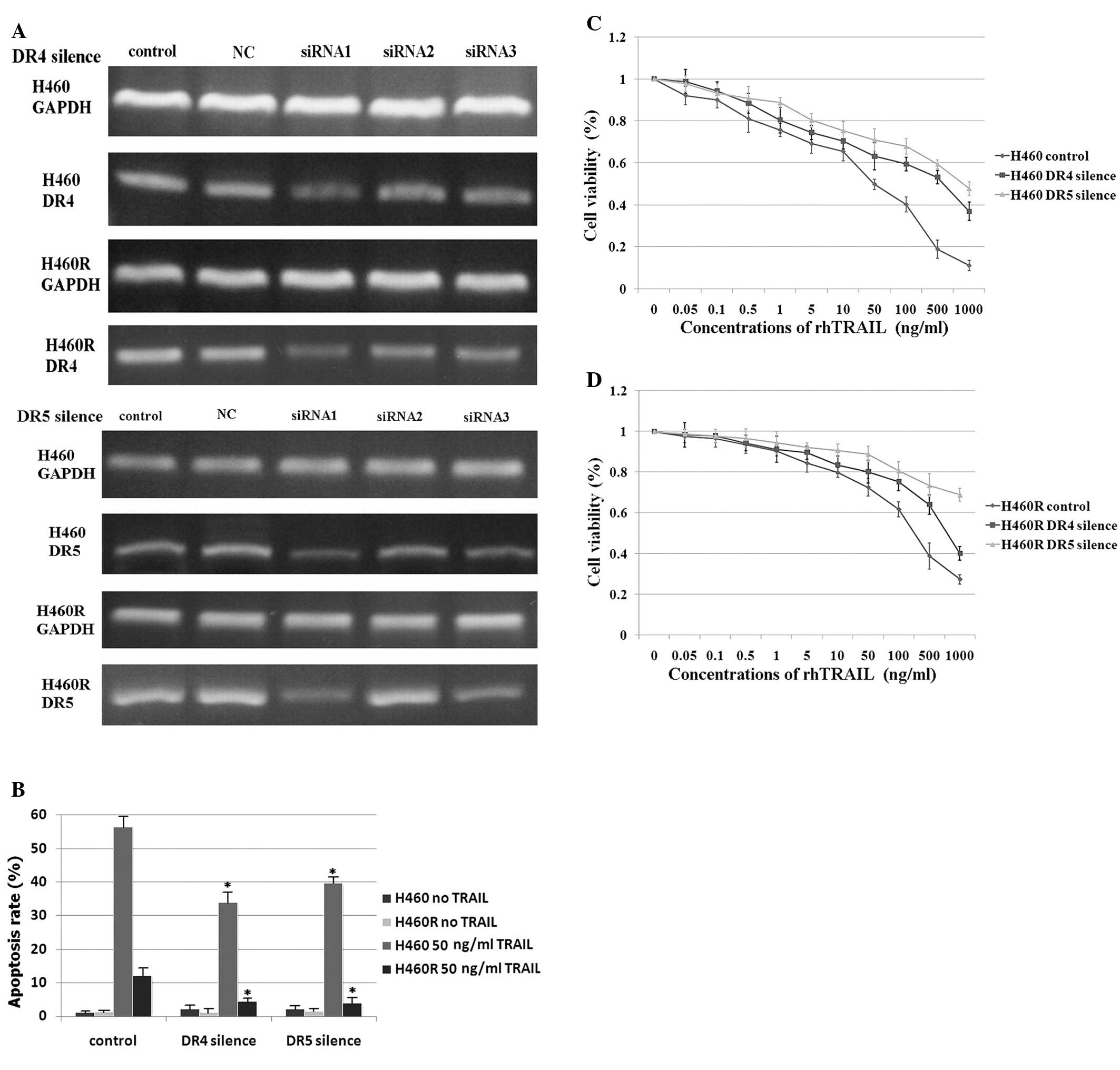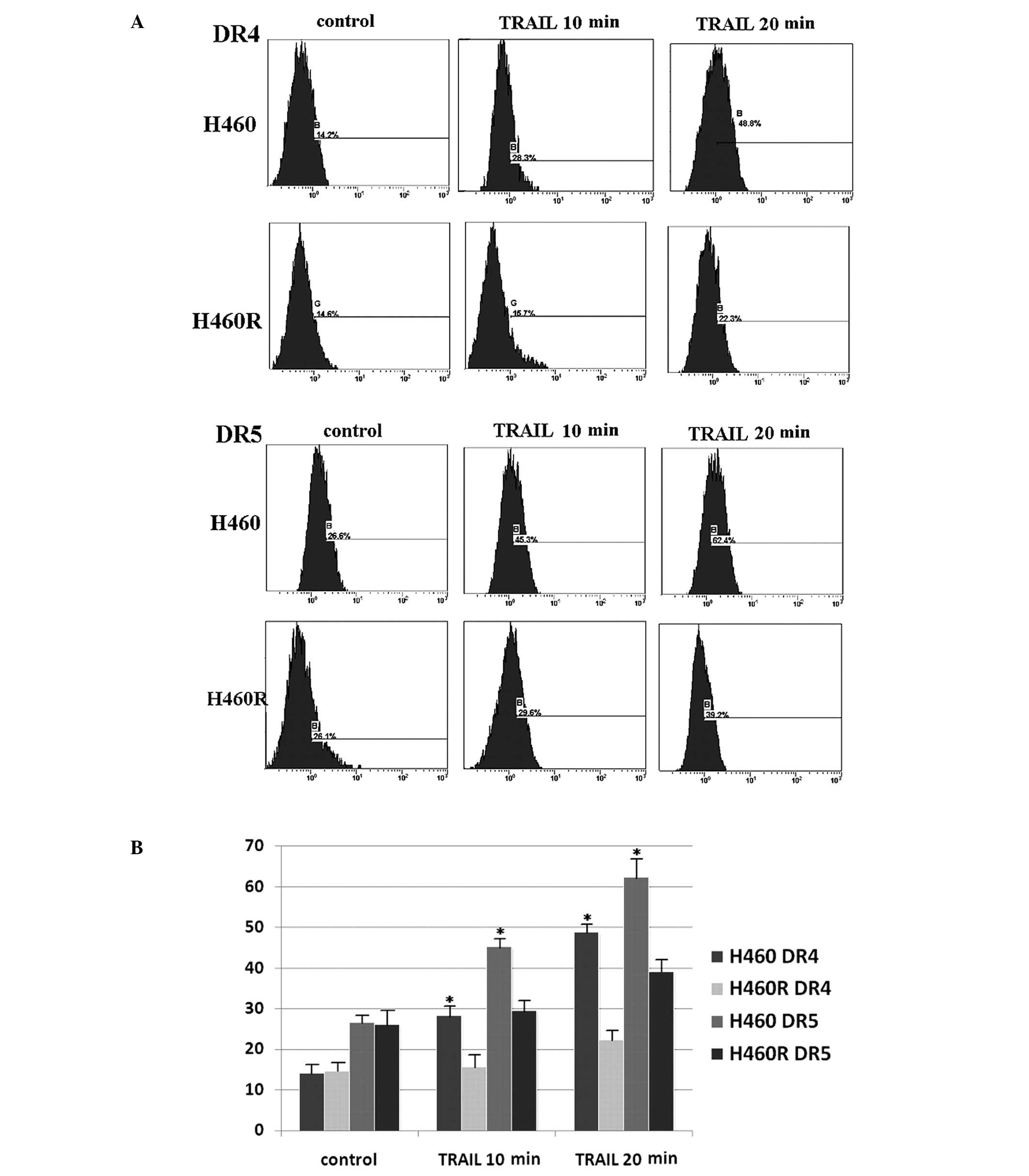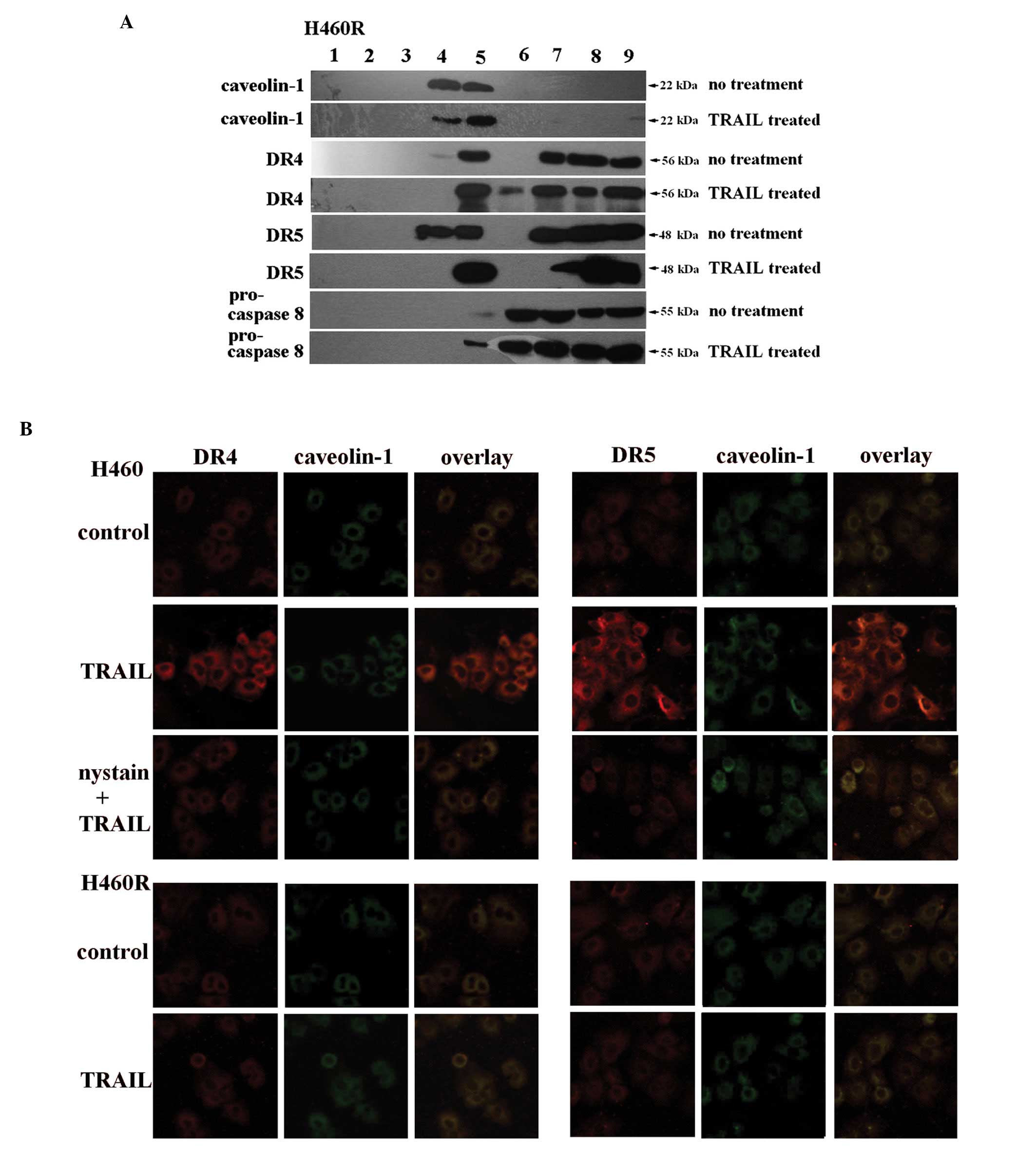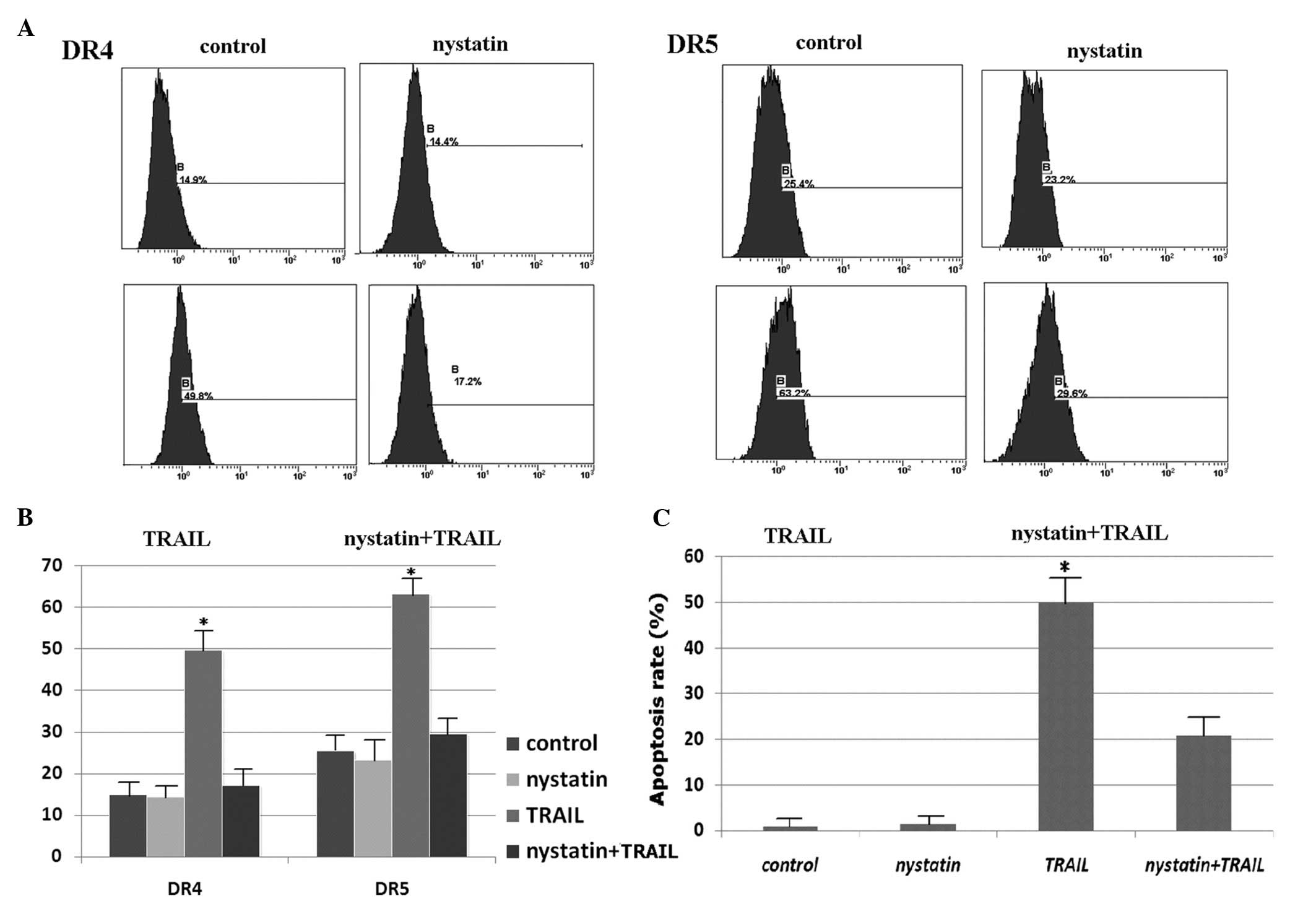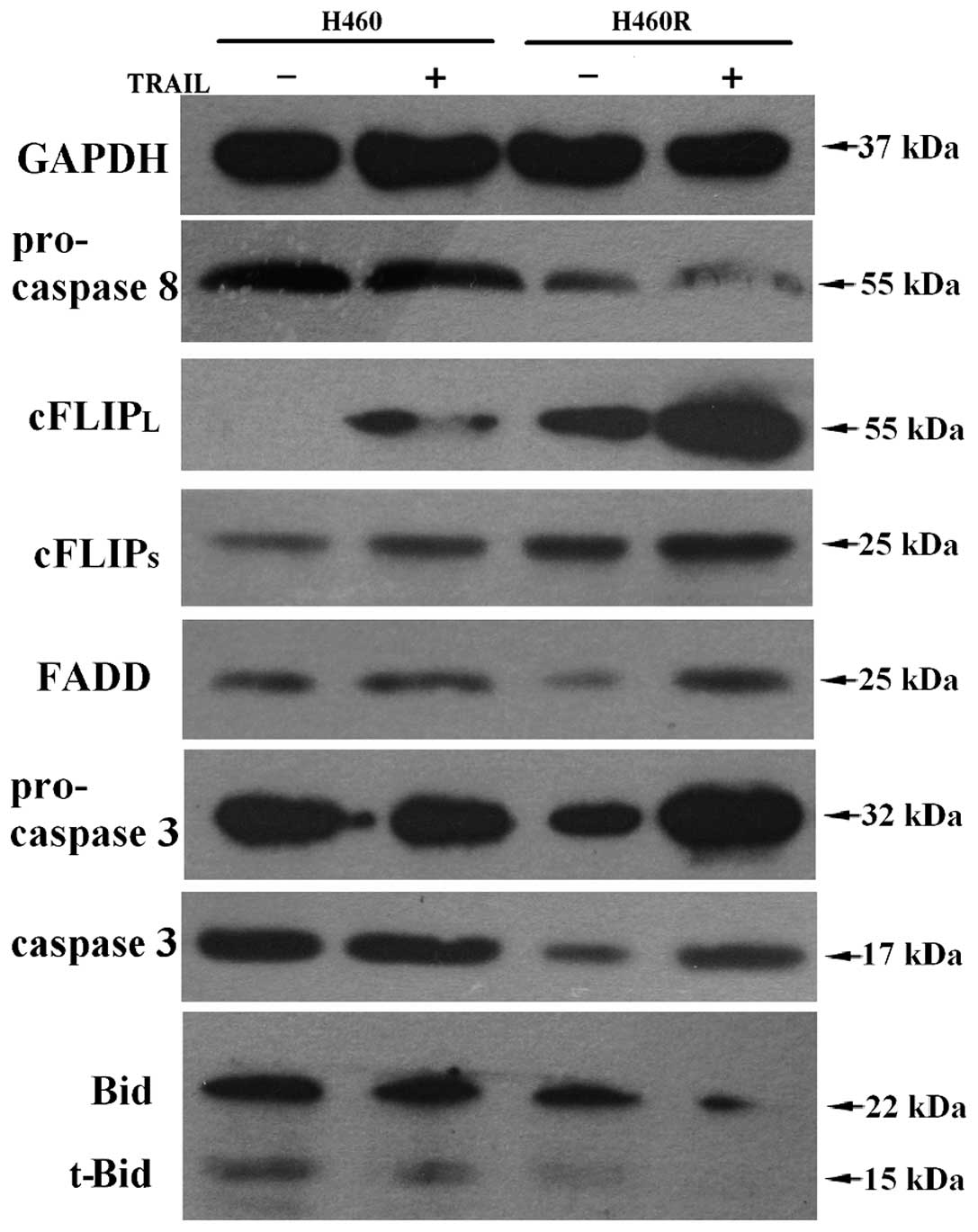|
1.
|
Wiley SR, Schooley K, Smolak PJ, Din WS,
Huang CP, Nicholl JK, Sutherland GR, Smith TD, Rauch C, Smith CA,
et al: Identification and characterization of a new member of the
TNF family that induces apoptosis. Immunity. 3:673–682. 1995.
View Article : Google Scholar : PubMed/NCBI
|
|
2.
|
Pitti RM, Marsters SA, Ruppert S, Donahue
CJ, Moore A and Ashkenazi A: Induction of apoptosis by Apo-2
ligand, a new member of the tumor necrosis factor cytokine family.
J Biol Chem. 271:12687–12690. 1996. View Article : Google Scholar : PubMed/NCBI
|
|
3.
|
Ichikawa K, Liu W, Zhao L, Wang Z, Liu D,
Ohtsuka T, Zhang H, Mountz JD, Koopman WJ, Kimberly RP and Zhou T:
Tumoricidal activity of a novel anti-human DR5 monoclonal antibody
without hepatocyte cytotoxicity. Nat Med. 7:954–960. 2001.
View Article : Google Scholar : PubMed/NCBI
|
|
4.
|
Hao C, Song JH, Hsi B, Lewis J, Song DK,
Petruk KC, Tyrrell DL and Kneteman NM: TRAIL inhibits tumor growth
but is nontoxic to human hepatocytes in chimeric mice. Cancer Res.
64:8502–8506. 2004. View Article : Google Scholar : PubMed/NCBI
|
|
5.
|
Gajewski TF: On the TRAIL toward death
receptor-based cancer therapeutics. J Clin Oncol. 25:1305–1307.
2007. View Article : Google Scholar : PubMed/NCBI
|
|
6.
|
Pan G, O’Rourke K, Chinnaiyan AM, Gentz R,
Ebner R, Ni J and Dixit VM: The receptor for the cytotoxic ligand
TRAIL. Science. 276:111–113. 1997. View Article : Google Scholar : PubMed/NCBI
|
|
7.
|
Pan G, Ni J, Wei YF, Yu G, Gentz R and
Dixit VM: An antagonist decoy receptor and a death
domain-containing receptor for TRAIL. Science. 277:815–818. 1997.
View Article : Google Scholar : PubMed/NCBI
|
|
8.
|
Johnstone RW, Frew AJ and Smyth MJ: The
TRAIL apoptotic pathway in cancer onset, progression and therapy.
Nat Rev Cancer. 8:782–798. 2008. View
Article : Google Scholar : PubMed/NCBI
|
|
9.
|
Luo X, Budihardjo I, Zou H, Slaughter C
and Wang X: Bid, a Bcl2 interacting protein, mediates cytochrome c
release from mitochondria in response to activation of cell surface
death receptors. Cell. 94:481–490. 1998. View Article : Google Scholar : PubMed/NCBI
|
|
10.
|
Ivanov VN, Bhoumik A and Ronai Z: Death
receptors and melanoma resistance to apoptosis. Oncogene.
22:3152–3161. 2003. View Article : Google Scholar : PubMed/NCBI
|
|
11.
|
Lane D, Cote M, Grondin R, Couture MC and
Piche A: Acquired resistance to TRAIL-induced apoptosis in human
ovarian cancer cells is conferred by increased turnover of mature
caspase-3. Mol Cancer Ther. 5:509–521. 2006. View Article : Google Scholar : PubMed/NCBI
|
|
12.
|
Lee TJ, Lee JT, Park JW and Kwon TK:
Acquired TRAIL resistance in human breast cancer cells are caused
by the sustained cFLIP(L) and XIAP protein levels and ERK
activation. Biochem Biophys Res Commun. 351:1024–1030. 2006.
View Article : Google Scholar : PubMed/NCBI
|
|
13.
|
Wang X, Chen W, Zeng W, Bai L, Tesfaigzi
Y, Belinsky SA and Lin Y: Akt-mediated eminent expression of c-FLIP
and Mcl-1 confers acquired resistanceto TRAIL-induced cytotoxicity
to lung cancer cells. Mol Cancer Ther. 7:1156–1163. 2008.
View Article : Google Scholar : PubMed/NCBI
|
|
14.
|
Zhang Land and Fang B: Mechanisms of
resistance to TRAIL-induced apoptosis in cancer. Cancer Gene Ther.
12:228–237. 2005. View Article : Google Scholar : PubMed/NCBI
|
|
15.
|
Jonsson G, Paulie S and Grandien A: High
level of cFLIP correlates with resistance to death receptor-induced
apoptosis in bladder carcinoma cells. Anticancer Res. 23:1213–1218.
2003.PubMed/NCBI
|
|
16.
|
Wagner KW, Punnoose EA, Januario T,
Lawrence DA, Pitti RM, Lancaster K, Lee D, von Goetz M, Yee SF,
Totpal K, Huw L, Katta V, Cavet G, Hymowitz SG, Amler L and
Ashkenazi A: Death-receptor O-glycosylation controls tumor-cell
sensitivity to the proapoptotic ligand Apo2L/TRAIL. Nat Med.
13:1070–1077. 2007. View
Article : Google Scholar : PubMed/NCBI
|
|
17.
|
Wu F, Hu Y, Long J, Zhou YJ, Zhong YH,
Liao ZK, Liu SQ, Zhou FX, Zhou YF and Xie CH: Cytotoxicity and
radiosensitization effect of TRA-8 on radioresistant human larynx
squamous carcinoma cells. Oncol Rep. 21:461–465. 2009.PubMed/NCBI
|
|
18.
|
Griffith TS, Rauch CT, Smolak PJ, Waugh
JY, Boiani N, Lynch DH, Smith CA, Goodwin RG and Kubin MZ:
Functional analysis of TRAIL receptors using monoclonal antibodies.
J Immunol. 162:2597–2605. 1999.PubMed/NCBI
|
|
19.
|
Jin Z, McDonald ER III, Dicker DT and
El-Deiry WS: Deficient tumor necrosis factor-related
apoptosis-inducing ligand (TRAIL) death receptor transport to the
cell surface in human colon cancer cells selected for resistance to
TRAIL-induced apoptosis. J Biol Chem. 279:35829–35839. 2004.
View Article : Google Scholar
|
|
20.
|
Cheng J, Hylander BL, Baer MR, Chen X and
Repasky EA: Multiple mechanisms underlie resistance of leukemia
cells to Apo2 Ligand/TRAIL. Mol Cancer Ther. 5:1844–1853. 2006.
View Article : Google Scholar : PubMed/NCBI
|
|
21.
|
Kand Simons and Vaz WL: Model systems,
lipid rafts, and cell membranes. Annu Rev Biophys Biomol Struct.
33:269–295. 2004. View Article : Google Scholar : PubMed/NCBI
|
|
22.
|
Cummins JM, Kohli M, Rago C, Kinzler KW,
Vogelstein B and Bunz F: X-linked inhibitor of apoptosis protein
(XIAP) is a nonredundant modulator of tumor necrosis factor-related
apoptosis-inducing ligand (TRAIL)-mediated apoptosis in human
cancer cells. Cancer Res. 64:3006–3008. 2004. View Article : Google Scholar
|
|
23.
|
Soderstrom TS, Poukkula M, Holmstrom TH,
Heiskanen KM and Eriksson JE: Mitogen-activated protein
kinase/extracellular signal-regulated kinase signaling in activated
T cells abrogates TRAIL-induced apoptosis upstream of the
mitochondrial amplification loop and caspase-8. J Immunol.
169:2851–2860. 2002. View Article : Google Scholar
|
|
24.
|
Song JH, Tse MC, Bellail A, Phuphanich S,
Khuri F, Kneteman NM and Hao C: Lipid rafts and nonrafts mediate
tumor necrosis factor related apoptosis-inducing ligand induced
apoptotic and nonapoptotic signals in non small cell lung carcinoma
cells. Cancer Res. 67:6946–6955. 2007. View Article : Google Scholar
|
|
25.
|
Vanoosten RL, Moore JM, Ludwig AT and
Griffith TS: Depsipeptide (FR901228) enhances the cytotoxic
activity of TRAIL by redistributing TRAIL receptor to membrane
lipid rafts. Mol Ther. 11:542–552. 2005. View Article : Google Scholar : PubMed/NCBI
|
|
26.
|
Delmas D, Rebe C, Micheau O, Athias A,
Gambert P, Grazide S, Laurent G, Latruffe N and Solary E:
Redistribution of CD95, DR4 and DR5 in rafts accounts for the
synergistic toxicity of resveratrol and death receptor ligands in
colon carcinoma cells. Oncogene. 23:8979–8986. 2004. View Article : Google Scholar : PubMed/NCBI
|
|
27.
|
Hao C, Song JH, Vilimanovich U and
Kneteman NM: Modulation of TRAIL signaling complex. Vitam Horm.
67:81–99. 2004. View Article : Google Scholar : PubMed/NCBI
|
|
28.
|
Ouyang W, Yang C, Liu Y, Xiong J, Zhang J,
Zhong Y, Zhang G, Zhou F, Zhou Y and Xie C: Redistribution of DR4
and DR5 in lipid rafts accounts for the sensitivity to TRAIL in
NSCLC cells. Int J Oncol. 39:1577–1586. 2011.PubMed/NCBI
|
|
29.
|
Siddik ZH: Cisplatin: mode of cytotoxic
action and molecular basis of resistance. Oncogene. 22:7265–7279.
2003. View Article : Google Scholar : PubMed/NCBI
|
|
30.
|
Sheikh MS, Huang Y, Fernandez-Salas EA,
El-Deiry WS, Friess H, Amundson S, Yin J, Meltzer SJ, Holbrook NJ
and Fornace AJ Jr: The antiapoptotic decoy receptor TRID/TRAIL-R3
is a p53-regulated DNA damage-inducible gene that is overexpressed
in primary tumors of the gastrointestinal tract. Oncogene.
18:4153–4159. 1999. View Article : Google Scholar : PubMed/NCBI
|
|
31.
|
Liu X, Yue P, Khuri FR and Sun SY: Decoy
receptor 2 (DcR2) is a p53 target gene and regulates
chemosensitivity. Cancer Res. 65:9169–9175. 2005. View Article : Google Scholar : PubMed/NCBI
|
|
32.
|
Zhang Yand and Zhang B: TRAIL resistance
of breast cancer cells is associated with constitutive endocytosis
of death receptors 4 and 5. Mol Cancer Res. 6:1861–1871. 2008.
View Article : Google Scholar : PubMed/NCBI
|
|
33.
|
Gomez-Benito M, Martinez-Lorenzo MJ, Anel
A, Marzo I and Naval J: Membrane expression of DR4, DR5 and
caspase-8 levels, but not Mcl-1, determine sensitivity of human
myeloma cells to Apo2L/TRAIL. Exp Cell Res. 313:2378–2388. 2007.
View Article : Google Scholar : PubMed/NCBI
|
|
34.
|
Horak P, Pils D, Haller G, Pribill I,
Roessler M, Tomek S, Horvat R, Zeillinger R, Zielinski C and
Krainer M: Contribution of epigenetic silencing of tumor necrosis
factor-related apoptosis inducing ligand receptor 1 (DR4) to TRAIL
resistance and ovarian cancer. Mol Cancer Res. 3:335–343. 2005.
View Article : Google Scholar
|
|
35.
|
Muppidi JR, Tschopp J and Siegel RM: Life
and death decisions: secondary complexes and lipid rafts in TNF
receptor family signal transduction. Immunity. 21:461–465. 2004.
View Article : Google Scholar : PubMed/NCBI
|
|
36.
|
Psahoulia FH, Drosopoulos KG, Doubravska
L, Andera L and Pintzas A: Quercetin enhances TRAIL-mediated
apoptosis in colon cancer cells by inducing the accumulation of
death receptors in lipid rafts. Mol Cancer Ther. 6:2591–2599. 2007.
View Article : Google Scholar : PubMed/NCBI
|
|
37.
|
Kand Simons and Toomre D: Lipid rafts and
signal transduction. Nat Rev Mol Cell Biol. 1:31–39. 2000.
View Article : Google Scholar
|
|
38.
|
Dimanche-Boitrel MT, Meurette O, Rebillard
A and Lacour S: Role of early plasma membrane events in
chemotherapy-induced cell death. Drug Resist Updat. 8:5–14. 2005.
View Article : Google Scholar : PubMed/NCBI
|
|
39.
|
Xu L, Qu X, Zhang Y, Hu X, Yang X, Hou K,
Teng Y, Zhang J, Sada K and Liu Y: Oxaliplatin enhances
TRAIL-induced apoptosis in gastric cancer cells by CBL-regulated
death receptor redistribution in lipid rafts. FEBS Lett.
583:943–948. 2009. View Article : Google Scholar
|
|
40.
|
Austin CD, Lawrence DA, Peden AA,
Varfolomeev EE, Totpal K, De Maziere AM, Klumperman J, Arnott D,
Pham V, Scheller RH and Ashkenazi A: Death-receptor activation
halts clathrin-dependent endocytosis. Proc Natl Acad Sci USA.
103:10283–10288. 2006. View Article : Google Scholar : PubMed/NCBI
|
|
41.
|
Ren YG, Wagner KW, Knee DA, Aza-Blanc P,
Nasoff M and Deveraux QL: Differential regulation of the TRAIL
death receptors DR4 and DR5 by the signal recognition particle. Mol
Biol Cell. 15:5064–5074. 2004. View Article : Google Scholar : PubMed/NCBI
|
|
42.
|
Hawash IY, Kesavan KP, Magee AI, Geahlen
RL and Harrison ML: The Lck SH3 domain negatively regulates
localization to lipid rafts through an interaction with c-Cbl. J
Biol Chem. 277:5683–5691. 2002. View Article : Google Scholar : PubMed/NCBI
|
|
43.
|
Qu X, Miah SM, Hatani T, Okazaki M,
Hori-Tamura N, Yamamura H, Hotta H and Sada K: Selective inhibition
of Fcepsilon RI-mediated mast cell activation by a truncated
variant of Cbl-b related to the rat model of type 1 diabetes
mellitus. J Biochem. 137:711–720. 2005. View Article : Google Scholar : PubMed/NCBI
|
|
44.
|
Lee KH, Feig C, Tchikov V, Schickel R,
Hallas C, Schutze S, Peter ME and Chan AC: The role of receptor
internalization in CD95 signaling. EMBO J. 25:1009–1023. 2006.
View Article : Google Scholar : PubMed/NCBI
|
|
45.
|
Schneider-Brachert W, Tchikov V, Neumeyer
J, Jakob M, Winoto-Morbach S, Held-Feindt J, Heinrich M, Merkel O,
Ehrenschwender M, Adam D, Mentlein R, Kabelitz D and Schutze S:
Compartmentalization of TNF receptor 1 signaling: internalized TNF
receptosomes as death signaling vesicles. Immunity. 21:415–428.
2004. View Article : Google Scholar : PubMed/NCBI
|
|
46.
|
Zhang Y, Yoshida T and Zhang B: TRAIL
induces endocytosis of its death receptors in MDA-MB-231 breast
cancer cells. Cancer Biol Ther. 8:917–922. 2009. View Article : Google Scholar : PubMed/NCBI
|
|
47.
|
Nam SY, Jung GA, Hur GC, Chung HY, Kim WH,
Seol DW and Lee BL: Upregulation of FLIP(S) by Akt, a possible
inhibition mechanism of TRAIL-induced apoptosis in human gastric
cancers. Cancer Sci. 94:1066–1073. 2003. View Article : Google Scholar : PubMed/NCBI
|
|
48.
|
Li H, Zhu H, Xu CJ and Yuan J: Cleavage of
BID by caspase 8 mediates the mitochondrial damage in the Fas
pathway of apoptosis. Cell. 94:491–501. 1998. View Article : Google Scholar : PubMed/NCBI
|















